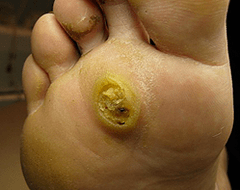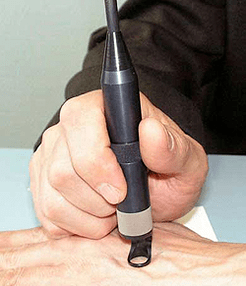Papilloma - Formation of benign skin tumors and mucous membranes of viral etiology.It has the appearance of a papilla on a narrow base (leg), of soft or dense consistency, from light brown color to dark brown.The location of papillomas on the skin leads to the formation of a cosmetic defect, in the breathing altered by larynx, the voice, on the mucosa of the internal organs - ulcers and bleeding.The relapses of the disease are possible, the most formidable complication is malignant degeneration.Papill removal can be carried out by electrocoagulation, cryodestruction, surgical excision, radio wave method or laser exposure.
general information
Papillomas - It is a disease that affects epithelial cells and skin.The cause of papillomas is the human papillomavirus, which belongs to the Papoviridae family, the Papillomavirus group.Among HPV, high and low oncogenic risk viruses are distinguished.Oncogenity butterfly is explained by the virus's ability to integrate its DNA into the genome of human cells.
The mechanism of infection by the human papilloma virus
Once in the human body, at the initial stage, the HPV affects the basal cells of the epithelium.Microtraums, scratches, cracks and other skin damage contribute to the penetration of the papillom virus into the body.For a long time, the virus can multiply mainly, without manifesting itself clinically (chronic trolley).If the virus spreads in the skin's surface layers, then over time, even with chronic transport of the papillom virus, cell hyperplasia is observed.
Since the human papillom virus is nested in the outside environment, the infection occurs with direct contacts.Forced sexual ties cause an infection;Smoking, pregnancy, endometriosis, vitamin deficiency, immunodeficiaries are predisposing factors so that infection occurs during interaction with the virus.The risk of infection increases with frequent contact with naked human skin, for example, with massage.
Clinical manifestations of papillomas
Papilloma is a neoplasm of the skin or mucous membranes and resembles papillary growth which protrudes above the surrounding tissues.The papillomas are located on the skin, the mucous membranes, in the inguinal region and on the genitals, in some cases, the papillomas are in the renal basin and on the mucosa of the ureters.
Since the papilloma consists of connective tissue covered with skin and contains blood vessels, bleeding is possible during trauma.The neoplasm grows upwards in the form of taste buds dispersed in various directions and resembles cauliflower.
The skin of the skin may not change, but in most cases, the guts have a color from white to dirty brown.Favorite location - The skin of brushes and hands.In patients with immunodeficiaries, papillomatosis is widespread.Primary changes in the skin begin to appear 1 to 6 months after infection.The concentration of the virus in the affected areas reaches the maximum of the 6th month from the moment of infection, it is this period which is the most contagious.
Depending on the type of virus, clinical manifestations of papillomas are variable.Thus, vulgar papillomas seem in the form of a solid bump with a diameter of 1 mm with a rough keratinating surface.Vulgar papillomas are subject to fusion and therefore often affect important areas of the skin.Simple (vulgar) papillomas are located everywhere, but more often, they are affected by the skin of the fingers and the back of the palms.In children, especially young people, are affected by papillomas, this is due to physiological characteristics, because children are crawling without clothes.As a rule, vulgar papillomas are located in groups, but an prolonged existence of a single element is possible for several years.Immunodeficiency conditions and general diseases contribute to the propagation of the process, in isolated cases, the vulgar papilloma is malignant.

The causal agents of papillomas are PAPC 1.2.4.A few months after the infection on the skin of the sole, a small brilliant bump appears, which has all the signs of ordinary papilloma and is surrounded by a salient edge.In some cases, small subsidiaries appear around a papilloma, which resemble bubbles outside.Then, the mosaic papillomatosis is diagnosed.
Papillomas on the soles are often painful, especially when they walk.In around 30% of cases, they are self-directing, most often autonomous treatment is observed in young children.They are often confused with horns that appear between the fingers with prolonged compression.However, the horns, unlike papillomas, have a smooth surface and keep the skin pattern.
Causal agents of flat papillomas are HPV 3.10.These papillomas of the color of the skin unchanged and look in the form of smooth flat cones, there can sometimes be a yellowish or slightly pink nuance more often rounded.There are also multiple papillomas.Neoplasms cause pain, itching, the affected area is hyperemic.

The cinema papillomas are diagnosed in half of those who have turned over 50 years on neoplasms on the skin, they are also called acrochords.They are located on the skin around the eyes, in the groin, in the axillary cavities and on the neck.First of all, a small yellowish shade appears, which increases and gradually converts into dense elongated elastic formations in size up to 5-6 mm.If the acrochords are located in places where trauma is possible, they become ignited and injured.Cinema papillomas are not subject to spontaneous disappearance.In patients with diagnosed threaded papillomas, rectum polyps are often observed.
The HPV 13, 32 causes local epithelial hyperplasia, which is characterized by the appearance on the mucosa of the mouth and on the red border of the lips of the small papillary neoplasms, which rise slightly above the skin and are subject to fusion.
One of the papillomas rarely found are the papillomas of Lewandovsky-Lutz (Epidermodisphelia Warty).Most of the time, children and adolescents are sick.Sometimes, the epidermodisplases in Veruquette are a family character.It looks clinically like several butterfly spotted by red brown on the hands and feet.If the papillomas are located in skin areas, which are most sensitive to ultraviolet radiation, then in 30% of cases, they are malignant and are reborn in malignant tumors with germination in neighboring tissues.
The HPV, which are the pathogens of the sharp condiles, may include a low, average and high risk of oncological degeneration, therefore, during the diagnosis of sharp confectionery, the PCR examination must always be carried out.The incubation period is from several weeks to several months.Since in some cases the changes are minimal, these papillomas remain unnoticed.The main transmission path is sexual.The risk group includes people with immunodeficiency and sexual partners who change often.Externally, they look like podrical pointed or pale gray pointed growth on the leg.
In most cases, pain, burn, itching, irritation during touch and friction with underwear is noted, often injured and bleed.They are located on the eve of the vagina, on the small lips, less often, spicy condylomas are in the vagina and on the cervix.In men, the urethra hole is affected.The damage area depends on the sexual behavior in this way, in people with anal contacts, sharp condylomas are found in the perineum and in the perianal area.In some cases, sharp condylomas are diagnosed on the oral mucosa and on the red border of the lips, which is again associated with the characteristics of sexual activity.
Larynx juvenile papillomas rarely record, they are caused by HPV 6.11;For the most part, children under the age of five are sick.The infection occurs during childbirth, when the woman at work has papillomas in the vagina and the child passing along the birth channel, takes a premature breath.The disease is characterized by papillary growth on the vocal beams, which leads to the difficulty of air circulation and speech disorders.
Diagnosis of papillomas
The diagnosis of papillomas is made by a dermatologist or a venereologist.Due to the large number of types of viruses, it has its own characteristics.It is possible to make an accurate diagnosis based on a visual inspection only in the classic case of sharp warts, but that does not give specific information type of virus and its oncogenicity.Consequently, in the event of suspicion of the papillomatous nature of neoplasms, they use the DNA DNA diagnoses of the virus.
The diagnosis of PCR makes it possible not only to confirm the presence of the human papillomavirus in the body and to determine its type, but also to diagnose the number of viruses in the body at the time of the analysis.This has a diagnostic value because, knowing the percentage of the virus content and its type, you can determine the approximate infection periods and identify contact persons in order to examine and prescribe preventive therapy.The diagnosis of PCR also gives information on the question of whether the papillomas has a chronic course or if it is a consequence of a simultaneous decrease in immunity.Thanks to such data, adequate therapy may be prescribed.
If the only treatment method is the elimination of papillomas, then parallel to surgery, a biopsy is carried out for cytological research.A histological examination of the tissue of papillomas gives more precise results, because the examination is subjected to cells such as cells, therefore the correct location of their layers and the structural characteristics of the tissue.This gives reliable results on the degree of changes in the body and on the probability of malignancy, because long-term and non-United Papillomas lead to cancer than HPV detected with a high degree of oncoris.
As a rule, the diagnosis of PCR is a screening for nature and, if the analysis confirms the presence of the virus, an additional study is carried out.
Papilloma treatment

The papilloma treatment regime in each case is individually selected.If a HPV is detected during the diagnosis, but there are not yet clinical manifestations, then preventive treatment is prescribed by cytostatics.It is quite effective and allows you to "sprinkle" the virus for several years.HPV patients are recommended to periodically examine the PCR and use barrier contraception, so as not to danger human infection to papillomavis by their partner.
Inozin Pranobex is a drug for the treatment of papillomas of the group of antiviral agents, which removes the reproduction of viruses.It is one of the most favorite, because it has immunomoduced properties.The indications for use are papillomas diagnosed with a combination of other viral infections, such as cytomegalovirus infections, measles and mumps.The presence of a herpes virus, chronic viral hepatitis and immunodeficiency also requires the inclusion of isoprinosin in the therapeutic scheme.Since the papilloma therapy is long, the Pranobex papillo should only be taken under the supervision of a doctor, as it is necessary to control the laboratory indicators.The use of immunomodulators and vitamin courses is shown to all patients with HPV.
If there are manifestations of HPV on the skin and mucous membranes, then, depending on location and symptoms, use the cryodestruction of papillomas, electrocoagulation or the elimination of the papill laser.It is possible to use another modern method of surgical treatment-degrading of papillomas with radio waves.If the papillome has signs of malignant tumors, then excision is carried out with a scalpel of the affected area with the capture of healthy fabrics.
It should be kept in mind that the elimination of papillomas does not lead to a complete recovery, because today there are no detailed drugs on HPV.Consequently, patients with previously diagnosed papillomas must periodically suffer an examination and organize antiviral therapy lessons.
Since HPV is mainly sexually transmitted, the only prevention of papillomas is the barrier contraception method.When planning pregnancy, it is necessary to diagnose and, if necessary, the treatment of the virus in order to reduce the probability of infection of the child during childbirth and in the first years of life.


















